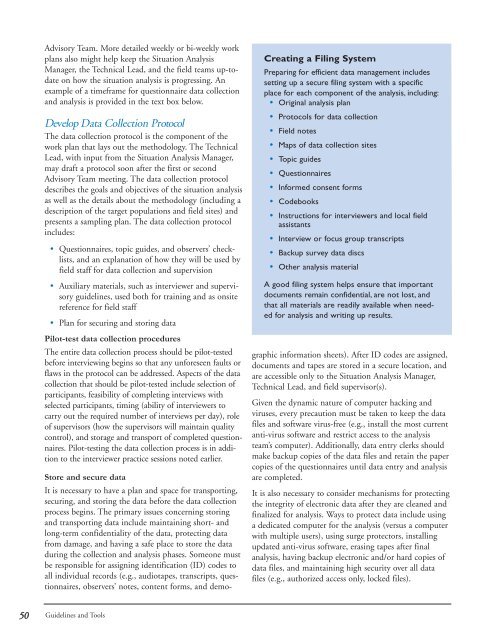Conducting a Participatory Situation Analysis of.pdf - Global HIV ...
Conducting a Participatory Situation Analysis of.pdf - Global HIV ...
Conducting a Participatory Situation Analysis of.pdf - Global HIV ...
Create successful ePaper yourself
Turn your PDF publications into a flip-book with our unique Google optimized e-Paper software.
Advisory Team. More detailed weekly or bi-weekly work<br />
plans also might help keep the <strong>Situation</strong> <strong>Analysis</strong><br />
Manager, the Technical Lead, and the field teams up-todate<br />
on how the situation analysis is progressing. An<br />
example <strong>of</strong> a timeframe for questionnaire data collection<br />
and analysis is provided in the text box below.<br />
Develop Data Collection Protocol<br />
The data collection protocol is the component <strong>of</strong> the<br />
work plan that lays out the methodology. The Technical<br />
Lead, with input from the <strong>Situation</strong> <strong>Analysis</strong> Manager,<br />
may draft a protocol soon after the first or second<br />
Advisory Team meeting. The data collection protocol<br />
describes the goals and objectives <strong>of</strong> the situation analysis<br />
as well as the details about the methodology (including a<br />
description <strong>of</strong> the target populations and field sites) and<br />
presents a sampling plan. The data collection protocol<br />
includes:<br />
• Questionnaires, topic guides, and observers’ checklists,<br />
and an explanation <strong>of</strong> how they will be used by<br />
field staff for data collection and supervision<br />
• Auxiliary materials, such as interviewer and supervisory<br />
guidelines, used both for training and as onsite<br />
reference for field staff<br />
• Plan for securing and storing data<br />
Pilot-test data collection procedures<br />
The entire data collection process should be pilot-tested<br />
before interviewing begins so that any unforeseen faults or<br />
flaws in the protocol can be addressed. Aspects <strong>of</strong> the data<br />
collection that should be pilot-tested include selection <strong>of</strong><br />
participants, feasibility <strong>of</strong> completing interviews with<br />
selected participants, timing (ability <strong>of</strong> interviewers to<br />
carry out the required number <strong>of</strong> interviews per day), role<br />
<strong>of</strong> supervisors (how the supervisors will maintain quality<br />
control), and storage and transport <strong>of</strong> completed questionnaires.<br />
Pilot-testing the data collection process is in addition<br />
to the interviewer practice sessions noted earlier.<br />
Store and secure data<br />
Creating a Filing System<br />
Preparing for efficient data management includes<br />
setting up a secure filing system with a specific<br />
place for each component <strong>of</strong> the analysis, including:<br />
• Original analysis plan<br />
• Protocols for data collection<br />
• Field notes<br />
• Maps <strong>of</strong> data collection sites<br />
• Topic guides<br />
• Questionnaires<br />
• Informed consent forms<br />
• Codebooks<br />
• Instructions for interviewers and local field<br />
assistants<br />
• Interview or focus group transcripts<br />
• Backup survey data discs<br />
• Other analysis material<br />
A good filing system helps ensure that important<br />
documents remain confidential, are not lost, and<br />
that all materials are readily available when needed<br />
for analysis and writing up results.<br />
It is necessary to have a plan and space for transporting,<br />
securing, and storing the data before the data collection<br />
process begins. The primary issues concerning storing<br />
and transporting data include maintaining short- and<br />
long-term confidentiality <strong>of</strong> the data, protecting data<br />
from damage, and having a safe place to store the data<br />
during the collection and analysis phases. Someone must<br />
be responsible for assigning identification (ID) codes to<br />
all individual records (e.g., audiotapes, transcripts, questionnaires,<br />
observers’ notes, content forms, and demographic<br />
information sheets). After ID codes are assigned,<br />
documents and tapes are stored in a secure location, and<br />
are accessible only to the <strong>Situation</strong> <strong>Analysis</strong> Manager,<br />
Technical Lead, and field supervisor(s).<br />
Given the dynamic nature <strong>of</strong> computer hacking and<br />
viruses, every precaution must be taken to keep the data<br />
files and s<strong>of</strong>tware virus-free (e.g., install the most current<br />
anti-virus s<strong>of</strong>tware and restrict access to the analysis<br />
team’s computer). Additionally, data entry clerks should<br />
make backup copies <strong>of</strong> the data files and retain the paper<br />
copies <strong>of</strong> the questionnaires until data entry and analysis<br />
are completed.<br />
It is also necessary to consider mechanisms for protecting<br />
the integrity <strong>of</strong> electronic data after they are cleaned and<br />
finalized for analysis. Ways to protect data include using<br />
a dedicated computer for the analysis (versus a computer<br />
with multiple users), using surge protectors, installing<br />
updated anti-virus s<strong>of</strong>tware, erasing tapes after final<br />
analysis, having backup electronic and/or hard copies <strong>of</strong><br />
data files, and maintaining high security over all data<br />
files (e.g., authorized access only, locked files).<br />
50<br />
Guidelines and Tools















